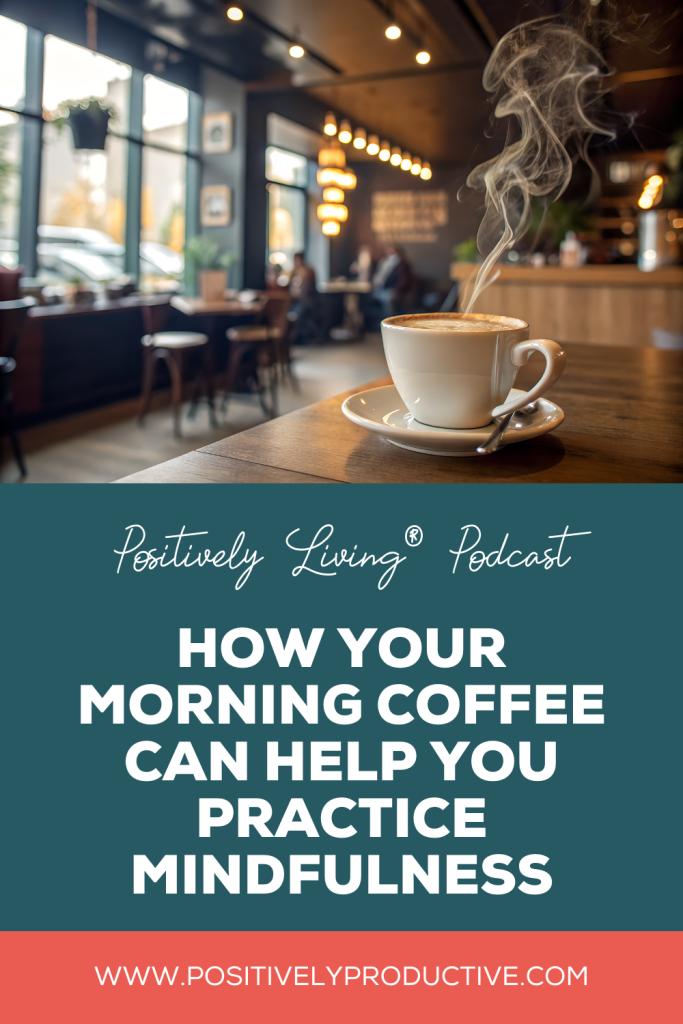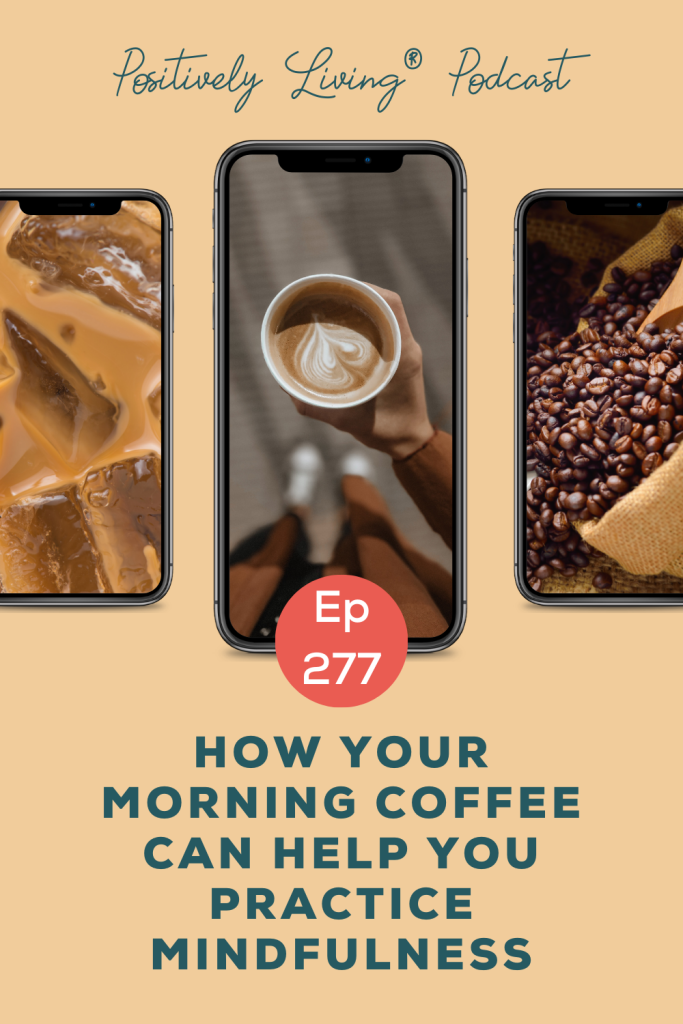Mindfulness sounds great in theory, but sometimes it can feel like just another “should” on your to-do list—something that is too difficult or time-consuming to actually do. (And you might feel guilty for not even trying). This resistance, known as productive “friction”, keeps us from building habits that can significantly boost our happiness and well-being.
In this episode of the Positively LivingⓇ Podcast, I break down the science and show you how simple and effective mindfulness can be. I share how to use everyday habits you already have as “mindfulness anchors,” turning your morning coffee, a shower, or a daily walk into a powerful practice that reshapes your brain for the better.
I cover the following topics:
- The surprising brain science behind mindfulness, including how it can physically rewire your brain to be happier and more resilient.
- Why traditional meditation practices can create a “friction problem” that makes us less likely to build the habit.
- How to use habit stacking to anchor mindfulness to routines you already have, making it simple and sustainable.
- Practical examples of how to practice mindfulness with your five senses during everyday moments like drinking coffee or showering.
- How practicing mindfulness can double as a gratitude practice, boosting your well-being with minimal effort.
Mindfulness doesn’t require a perfect environment or a new app—it just requires a moment of awareness. The best time to practice is in the moments you’re already living.
The Simple Guide to Mindfulness: How to Practice in the Moments You Already Live
Does the idea of mindfulness sound great but feel impossible to actually do? You are not alone. So many people believe that practicing mindfulness means sitting perfectly still in silence for 30 minutes, or finding a perfect, calm environment—which feels completely out of reach if you have a packed schedule, a noisy house, or caregiving responsibilities. This makes mindfulness feel like another “should” you can’t get to, leading to guilt and a feeling of failure. What if mindfulness was actually so much simpler than that? What if the best time to practice was in the moments you are already living?
This article is for you if you want to find more happiness and peace, but struggle with traditional meditation and mindfulness practices. We will take the friction out of building this powerful habit by showing you how to use the routines you already have as simple, built-in opportunities to pause and practice.
The Brain Science Behind Mindfulness
Before we dive into the “how,” let us quickly review the incredible benefits of mindfulness so you know why this habit is worth it. Our minds wander nearly half the time, and when they do, we are less happy. Mindfulness trains your brain to return to the present moment, which directly supports your happiness and well-being.
What is even more fascinating is that mindfulness physically changes your brain! This is called neuroplasticity, which is your brain’s ability to rewire itself based on repeated experiences. Studies show that regular mindfulness practice can thicken regions of the brain tied to learning, memory, and emotional regulation. At the same time, the amygdala—the part of the brain linked to fear and stress—actually shrinks. This is an incredible one-two punch that rewires your brain to be less stressed and much happier in the long run.
Quick Wins & Key Takeaways:
- A wandering mind is a less happy mind, but mindfulness can train it to be more present.
- Mindfulness physically rewires your brain, a process called neuroplasticity.
- Regular practice thickens brain regions tied to happiness and emotional regulation.
- The part of your brain that handles fear and stress actually shrinks with practice.
Ditch the Friction: How to Practice Mindfulness Simply
Many of us struggle to practice mindfulness because of what I call a friction problem. Traditional practices often have too much effort, too many steps, and too many barriers, making them less likely to become a habit. You might believe you need to meditate perfectly in a quiet room, but this is an unrealistic approach that only leads to guilt and a feeling of failure.
The good news is that mindfulness is so much simpler than that! It is a skill in noticing the present moment with acceptance, which you can do anywhere and anytime. You do not need a new app or a perfect environment; you just need a moment of awareness. The key is to take the friction away by linking a new practice onto a habit you already have. This is called habit stacking, and it creates a natural anchor for your new mindfulness practice, making it feel almost effortless.
Quick Wins & Key Takeaways:
- A “friction problem” is when a habit has too many barriers, making it hard to stick to.
- Mindfulness is simply noticing the present moment with acceptance, which you can do anywhere.
- Use “habit stacking” to link mindfulness to a routine you already have.
- You can take the friction away by practicing for just two minutes, not 30.
Everyday Habits as Mindfulness Anchors
Ready to start? You do not have to add anything new to your schedule. Simply use a routine you already have as an anchor for a mindfulness moment. Here are some examples of how to use your five senses to make a simple moment a powerful practice.
Your Morning Coffee or Tea
I started with my morning coffee. Instead of rushing through it, I would slow down and notice the sound of the water brewing. I would watch the swirl of cream in the dark liquid. I would savor the warmth of the mug in my hands and the flavor of the coffee. This simple act of paying attention with my senses turned my daily coffee ritual into a powerful mindfulness practice.
Your Daily Drive
Sometimes, I will challenge myself to drive in silence for a bit. Instead of turning on a podcast, I’ll look around and notice the changes in the landscape. I pay attention to the seasonal shifts or the new businesses opening up. Noticing what is happening around you is a simple mindfulness practice, and you can do it every single time you drive. You will be surprised by how much you notice.
Your Shower
The shower is a fantastic place for quiet and a moment to be present. It is a great time to take deep breaths and notice the scent of your favorite body wash. Feel the water cascading down your back and listen to the sound it makes. This moment can be a mindfulness practice that soothes aching muscles and calms a busy mind.
A Simple Start to a Powerful Habit
Mindfulness is a practice for a reason; you do not need to aim for perfection. It is about trying, about noticing, and about returning to the present moment. The great news is that one simple practice can have incredible efficiency because it can also double as a gratitude practice. When you appreciate what you are noticing, you are not only being mindful, you are also being grateful.
Here is your action plan to get started:
- Choose an Anchor: Pick a routine you already do every day, like drinking your coffee, showering, or taking a walk.
- Use Your Senses: For just two minutes, focus on what you can hear, see, smell, taste, and touch during that activity.
- No Judgment: If your mind wanders, gently guide it back to the present moment without frustration.
The best time to practice mindfulness is in the moments you are already living. Start with one routine today, and see what you discover.
Thank you for listening! If you enjoyed this episode, take a screenshot of the episode to post in your stories and tag me! And don’t forget to follow, rate, and review the podcast and tell me your key takeaways!
Learn more about Positively LivingⓇ and Lisa at https://positivelyproductive.com/podcast/
Stop trying to fit into someone else’s productivity rules! Grab my free Productivity Toolkit, a collection of workbooks designed to help you explore how you work, uncover what truly matters to you, and create your very own energy-friendly systems. Get it here: www.positivelyproductive.com/plpkit
CONNECT WITH LISA ZAWROTNY:
LINKS MENTIONED IN THIS EPISODE:
Atomic Habits by James Clear
(Find links to books/gear on the Positively Productive Resources Page.)
Dance Song Playlist V1, V2, V3
Music by Ian and Jeff Zawrotny
Start your own podcast with Buzzsprout!











